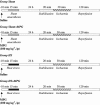Free-radical production triggered by hyperthermia contributes to heat stress-induced cardioprotection in isolated rat hearts
- PMID: 11934819
- PMCID: PMC1573285
- DOI: 10.1038/sj.bjp.0704619
Free-radical production triggered by hyperthermia contributes to heat stress-induced cardioprotection in isolated rat hearts
Abstract
1. Heat stress (HS) is known to protect the myocardium against ischaemic damage. It has been reported that reactive oxygen species (ROS) are abundantly produced during this stress. Since mechanisms triggering the HS-induced cardioprotection remain unknown, we investigated the role of ROS in the genesis of this protective phenomenon. 2. Rats were divided into four groups (n=8 in each group), subjected to either hyperthermia (42 degrees C internal temperature for 15 min) or sham anaesthesia and treated or not with N-2-mercaptopropionyl glycine (MPG), a synthetic antioxidant, 10 min before HS. Twenty-four hours later, their hearts were isolated, retrogradely perfused, and subjected to a 30-min occlusion of the left coronary artery followed by 120 min of reperfusion. Myocardial Hsp 27 and 70 expression was assessed by Western blot analysis (n=4). Cardiac activities of antioxidant enzymes (superoxide dismutase and glutathione peroxidase) were also examined (n=4). 3. Infarct-to-risk zone ratio was significantly reduced in HS (17+/-1.3%) compared to Sham (34.3+/-1.7%) hearts. This effect was abolished by MPG pretreatment (40.6+/-1.9% in HS+MPG vs. 39.8+/-2.5% in Sham+MPG hearts). This cardioprotection was associated with an enhanced Hsp 27 and 70 expression, which was not modified by MPG pretreatment. Antioxidant enzyme activities was not modified by heat stress or MPG pretreatment. 4. Free radical production following hyperthermia appears to play a role in the heat stress induced cardioprotection, independently of Hsp levels. Antioxidant enzyme activities do not seem to be implicated in this cardioprotective mechanism.
Figures




References
-
- BOLLI R. The late phase of preconditioning. Circ. Res. 2000;87:972–983. - PubMed
-
- BOLLI R., JEROUDI M.O., PATEL B.S., ARUOMA O.I., HALLIWELL B., LAI E.K., MCCAY P.B. Marked reduction of free radical generation and contractile dysfunction by antioxidant therapy begun at the time of reperfusion. Evidence that myocardial ‘stunning' is a manifestation of reperfusion injury. Circ. Res. 1989;65:607–622. - PubMed
-
- CURRIE R.W., KARMAZYN M., KLOC M., MAILER K. Heat-shock response is associated with enhanced postischemic ventricular recovery. Circ. Res. 1988;63:543–549. - PubMed
-
- DONNELLY T.J., SIEVERS R.E., VISSERN F.L., WELCH W.J., WOLFE C.L. Heat shock protein induction in rat hearts. A role for improved myocardial salvage after ischemia and reperfusion. Circulation. 1992;85:769–778. - PubMed
MeSH terms
Substances
LinkOut - more resources
Full Text Sources
Medical

